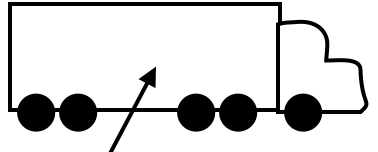8.
Newton's Second Law
The net force on an object is the sum of all of the forces acting on it. These forces need to be added as vectors (as we see in Adding Vectors). If the net force is zero, that means that the forces are balanced, and the system is in equilibrium: its velocity remains unchanged.If the net force is not zero, that means the object's velocity is changing. The rate of change in velocity is called acceleration. In fact, the net force and acceleration are proportional to each other, which is the content of Newton's Second Law:
The acceleration of an object is equal to the net force on it, divided by its mass.
$$\vec a=\frac{\vec F_{net}}{m}$$
Mass is a measure of how difficult it is to make an object change direction or speed; the larger the mass, the smaller the acceleration for the same force. This property is called inertia.
Think again about the truck colliding with the mosquito. Both feel the same force during the collision, according to Newton's Third Law. However...
Column

Column

In other words, force is the cause and acceleration is the effect, and our gut feeling in this case is focused on the effect.